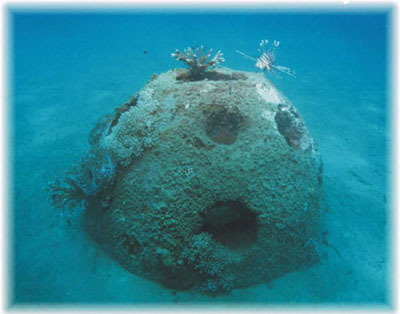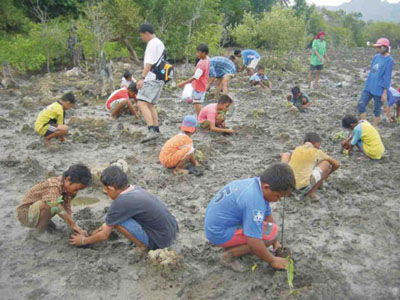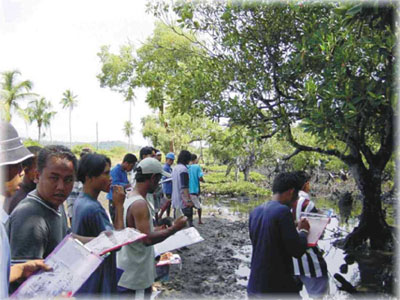for Reef Ball manufacturing and provided
construction training to local residents, who are contracted
to make the Reef Balls. Increased revenues through increased
fishery resources are already being demonstrated by increased
fishing activity over the Reef Ball sites established in 1999.
Additional micro-finance programs for the local fishery
enterprises (e.g., funding for boats, engines, cold
storage facilities, etc.) implemented by Newmont are
designed to ensure the long-term sustainability of the fishing
industry in the area.
Social benefits of the project arise from the
full inclusion and participation of local residents
demonstrating the connection between environmental
conservation and increased resources for the local
communities. Training and education (techniques in sustainable
fishing, processing, storing, transporting and marketing)
programs implemented by Newmont will further enhance the
sustainability of program.
Measurable Results
Surveys of Reef Ball sites have been ongoing
at Minahasa since 1999 to monitor the development of the
artificial reefs. The survey techniques employed are
internationally established protocols for description and
quantification of coral ecosystem components and are conducted
by divers using SCUBA. These surveys have been conducted by
independent scientists, scientists from Sam Ratulangi
University in Manado and scientific staff of Newmontís
Environmental Department. The surveys of the Reef Ball sites
are being conducted on a quarterly basis. Time-series results
of surveys conducted at Reef Ball sites may therefore be used
to quantify and document coral growth and changes in abundance
and composition of coral fish communities.
Mangrove rehabilitation is planned for a
total of 5 ha in the local area. To date, 1 ha has been
rehabilitated and approximately 10,000 mangrove seedlings of
local species have been produced in the community nursery.
Measurement and quantification of the resulting mangrove
habitat (both in terms of area and number of trees) is
therefore relatively simple.
Qualitative fish catch information may also
be derived by systematic interviews with fishermen and women.
For example, questions and documentation of data regarding
fish caught (e.g., type, size, weight, value,
etc.) will provide an indication of the impacts of the
Reef Ball and Mangrove Rehabilitation projects on the local
fishery industry. These surveys/interviews would be conducted
on a regular basis to qualitatively assess temporal trends in
the quantity and quality of fish caught in local waters.

Replicability
The application of the Marine Habitat
Enhancement Program to other coastal sites is highly
appropriate given the programís simplicity, relatively low
implementation costs and short-term realization of benefits to
the local marine environment, coastal habitat and fishery
resources. Since 1999 at Minahasa, approximately 3000 Reef
Balls have been deployed at three main locations,
demonstrating that significant artificial reef initiation can
be achieved in a relatively short time span. The Minahasa site
represents the largest Reef Ball Project undertaken by a
private company in the world, and second only in size to the
Reef Ball Project implemented by the Malaysian Government.
The replicability of the project has been
demonstrated by a recent agreement between Newmont and two
Diving Centres in Manado, whereby Newmont will provide
approximately 300 Reef Balls for establishing two artificial
reefs (house reefs) for the centres. Other coastal villages
have also requested Reef Ball deployment in their local waters
and plans are currently underway to extend the Reef Ball
Project to these nearby villages. Additional Reef Ball
projects in Asia, Australia, Middle East, North and South
America demonstrate the ease of replication of this marine
habitat enhancement technique.
Considerable local expertise in Mangrove
Rehabilitation has been developed as part of this program. A
community organization responsible for the Mangrove
Rehabilitation Project, which is managed by local residents,
has recently been established. This organization has drafted a
zone plan (including areas for conservation, plantation,
aquaculture and recreation) which has been submitted for
ratification by the Village Assembly.

Innovation/Inspiration
Although the technology employed in this
project is not new, Reef Balls have been deployed in over
1,500 projects worldwide, the integration of this technique
with a comprehensive Marine Habitat Enhancement Program has
resulted in a significant advance in sustainable fishing
practices and environmental awareness in the area of the
Minahasa Mine. The community participatory approach embraced
by this project has also promoted a real feeling of ownership
by all partners, in general, and the local residents, in
particular.
Mangrove species selection by local community
members has resulted in significant innovation on a local
scale. The community organization responsible for mangrove
rehabilitation has also led the process of assessing the
suitability of species for their local area and conditions.
This participatory approach has also been a significant source
of inspiration for local residents that can observe the
results of their efforts in enhancing their local
environment.
Partnerships
Newmont considers local communities,
government officials, lending agencies and non-government
organizations to be its partners in implementing sustainable
mining practices at all its sites. Newmont pledge to its
partners is a legacy of increased prosperity, healthier,
better-educated people with marketable job skills, and at
closure, reclamation of the environment to a level consistent
with pre-mining use.


Several organizations and community groups
have been collaborating in the Reef Ball Project. The
principal partners in the project were the Marine Ecology
Department at Sam Ratulangi University in Manado, Association
of Scientific Divers (ASPISIA-NGO), the Reef Ball Foundation,
Water Police, local government, local residents and Newmont.
These groups and organizations have been involved in various
aspects of the Reef Ball Project including Reef Ball
fabrication, site selection, ocean deployment and ecological
monitoring of the artificial reefs. The Water Police, which
have been established and funded by Newmont, are responsible
for reporting and arrest (in case of repeat offenders) of
people engaged in illegal fishing practices, such as reef
bombing and poisoning.
Initial training of local communities in
mangrove rehabilitation techniques and protocols was conducted
by University of Sam Ratulangi, ASPISIA and Newmont.
Subsequently the local communities have led the processes of
site selection, species selection, growing of mangrove
seedlings and planting and mangrove habitat monitoring. It is
envisaged that the recently developed community



